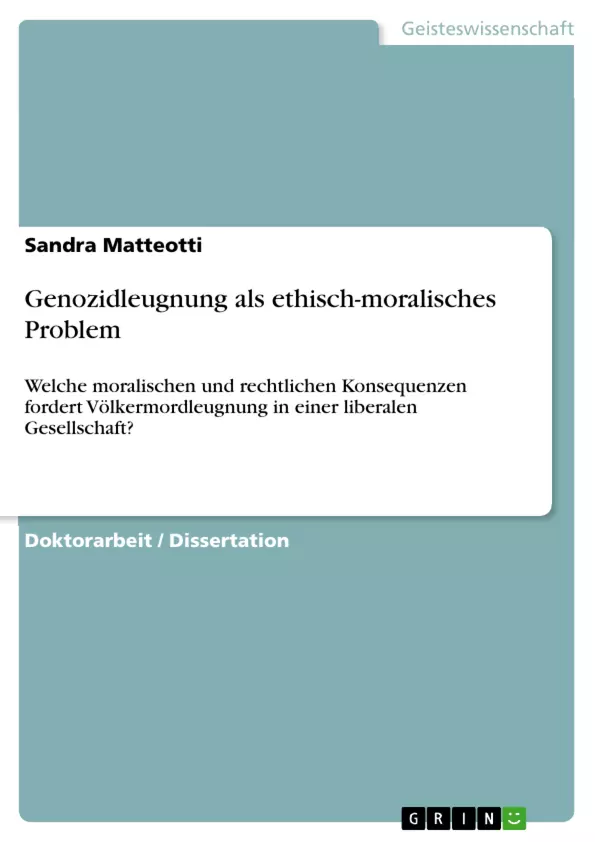Die Dissertation untersucht die Frage, ob und – wenn ja: – wie eine rechtliche Auseinandersetzung mit der Leugnung von Völkermord erfolgen soll oder muss: Soll das, was moralisch gefordert erscheint, auch rechtlich durchgesetzt werden? Diese Fragestellung ergibt sich als rechtliche und moralische Folgerung aus einem Verständnis des Völkermords als historisches Unrecht.
Im Zuge des Demokratisierungsprozesses nach der Beseitigung eines Unrechtsregimes geht es wesentlich (auch) darum, Gerechtigkeit (wieder) herzustellen: Die Vergangenheit soll und muss aufgearbeitet werden und den Opfern des Regimes und ihren Nachfahren Wiedergutmachung sowie vor allem Anerkennung und Respekt erwiesen werden, um einen gesellschaftlichen Neuanfang zu ermöglichen.
Ein zentraler Punkt ist dabei unter anderem die Anerkennung des Opferstatus, dessen Negierung oft ein zweites Unrecht am Opfer bedeuten würde, weil das erlittene historische Unrecht eine wichtige Komponente in der persönlichen und sozialen Identität der Opfer und der Gruppe der Opfer darstellt.
Die Dissertation will aufzuzeigen, inwiefern es sich bei dem Anspruch der Opfer auf öffentliche Anerkennung als Opfer um einen moralischen Anspruch handelt und welche rechtlichen Ansprüche daraus abgeleitet und geltend gemacht werden können und sollten.
Subject of the PhD dissertation is the question if and – if so: – how a legal answer
to genocide denial should or must be given. Should a morally legitimised answer be forced by law? This question results from a legal and moral understanding of genocide as a historical injustice.
In the process of democratisation after the end of an injust regime it is of crucial importance to re-establish justice: The past has to and must be examinated, and the victims and their decendants have to be compensated, especially by acknowledging their sufferings, by (re-) establishing respect for them as individuals and as a group / as groups, and by compensating them, because otherwise a real new beginning for the society seems impossible.
A crucial / central point in this process is the acknowledgement of the victims' status. A negation would be a second injustice to them because the historical injustice they had to sustain is now an important part of their personal a social identity as single victims and as a group of victims.
The dissertation will demonstrate that the victims' demand for a public
acknowledgement of their suffering is a moral one / a moral requirement and that - and which [...]
Inhaltsverzeichnis
- Einführung
- Einführung in das Thema
- Bedeutung der Forschungsarbeit
- Forschungsstand
- Zur Literatur über den Umgang mit historischem Unrecht
- Grundlagen zum Verhältnis von Moral und Recht
- Historisches Unrecht
- Grundlagen der juristischen Verfolgung von Völkermordleugnung
- Zu schliessende Forschungslücken
- Fragestellung, These und Aufbau
- Das Verhältnis von Moral und Recht
- Das Gute und das Rechte
- Moral - universell oder wandelbar?
- Recht als zeitgebundenes Sanktionssystem
- Recht, Moral und menschliche Verantwortung
- Historisches Unrecht
- Einführung
- Natürliche Rechte
- Natürliches Verbrechen
- Der Begriff des historischen Unrechts
- Völkermord als historisches Unrecht
- Zwei historische Beispiele für Völkermorde
- Der Holocaust
- Der Völkermord an den Armeniern
- Rassische Vorurteile und ihre Folgen
- Was kann als Völkermord qualifiziert werden?
- Fazit
- Historische Wahrheit und deren Leugnung
Zielsetzung und Themenschwerpunkte
Die Arbeit setzt sich mit dem Problem der Genozidleugnung auseinander und untersucht die ethisch-moralischen Konsequenzen, die sie in einer liberalen Gesellschaft nach sich zieht. Die Autorin analysiert das Verhältnis von Moral und Recht im Kontext von historischem Unrecht und befasst sich mit der Frage, wie Völkermordleugnung juristisch verfolgt werden kann.
- Die ethische und moralische Dimension von Genozidleugnung
- Das Verhältnis von Moral und Recht im Kontext historischer Verbrechen
- Die juristische Verfolgung von Völkermordleugnung in einer liberalen Gesellschaft
- Der Begriff des historischen Unrechts und seine Anwendung auf Genozide
- Die Rolle der historischen Wahrheit im Umgang mit Völkermordleugnung
Zusammenfassung der Kapitel
Die Einleitung führt in das Thema der Genozidleugnung ein und erläutert die Bedeutung der Forschungsarbeit. Sie beleuchtet den aktuellen Forschungsstand zum Umgang mit historischem Unrecht, insbesondere zur Verfolgung von Völkermordleugnung. Das zweite Kapitel widmet sich dem Verhältnis von Moral und Recht, untersucht verschiedene Konzepte von Moral und Recht und stellt die Verbindung zwischen moralischen und rechtlichen Normen her. Das dritte Kapitel behandelt das Konzept des historischen Unrechts, fokussiert auf die Definition und Anwendung des Begriffs im Kontext von Genoziden und beleuchtet die Bedeutung der Erinnerung an historische Verbrechen.
Schlüsselwörter
Genozidleugnung, ethisch-moralisches Problem, historisches Unrecht, Völkermord, Recht, Moral, Menschenrechte, Erinnerungskultur, liberale Gesellschaft, juristische Verfolgung.
- Arbeit zitieren
- Sandra Matteotti (Autor:in), 2011, Genozidleugnung als ethisch-moralisches Problem, München, GRIN Verlag, https://www.grin.com/document/167222



